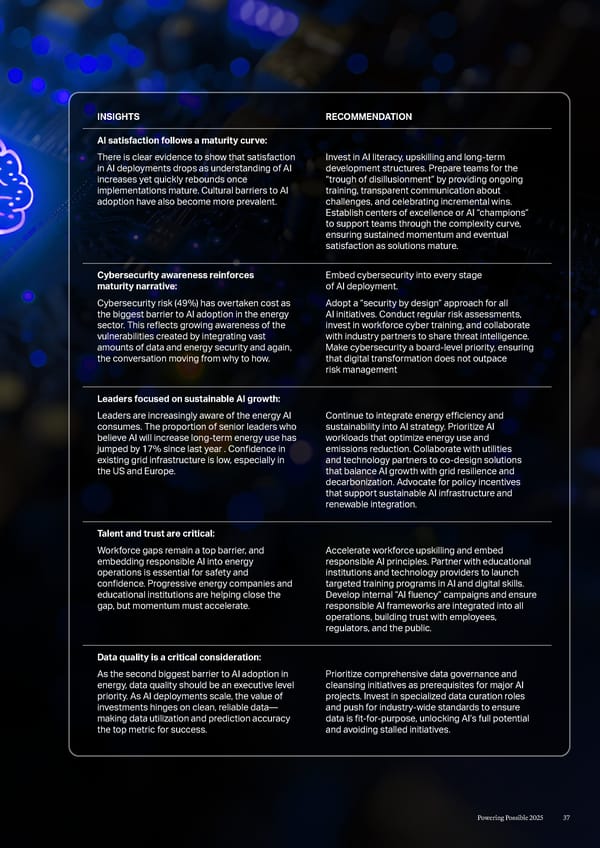INSIGHTS RECOMMENDATION AI satisfaction follows a maturity curve: There is clear evidence to show that satisfaction in AI deployments drops as understanding of AI increases yet quickly rebounds once implementations mature. Cultural barriers to AI adoption have also become more prevalent. Invest in AI literacy, upskilling and long-term development structures. Prepare teams for the “trough of disillusionment” by providing ongoing training, transparent communication about challenges, and celebrating incremental wins. Establish centers of excellence or AI “champions” to support teams through the complexity curve, ensuring sustained momentum and eventual satisfaction as solutions mature. Cybersecurity awareness reinforces maturity narrative: Cybersecurity risk (49%) has overtaken cost as the biggest barrier to AI adoption in the energy sector. This reflects growing awareness of the vulnerabilities created by integrating vast amounts of data and energy security and again, the conversation moving from why to how. Embed cybersecurity into every stage of AI deployment. Adopt a “security by design” approach for all AI initiatives. Conduct regular risk assessments, invest in workforce cyber training, and collaborate with industry partners to share threat intelligence. Make cybersecurity a board-level priority, ensuring that digital transformation does not outpace risk management Leaders focused on sustainable AI growth: Leaders are increasingly aware of the energy AI consumes. The proportion of senior leaders who believe AI will increase long-term energy use has jumped by 17% since last year . Confidence in existing grid infrastructure is low, especially in the US and Europe. Continue to integrate energy efficiency and sustainability into AI strategy. Prioritize AI workloads that optimize energy use and emissions reduction. Collaborate with utilities and technology partners to co-design solutions that balance AI growth with grid resilience and decarbonization. Advocate for policy incentives that support sustainable AI infrastructure and renewable integration. Talent and trust are critical: Workforce gaps remain a top barrier, and embedding responsible AI into energy operations is essential for safety and confidence. Progressive energy companies and educational institutions are helping close the gap, but momentum must accelerate. Accelerate workforce upskilling and embed responsible AI principles. Partner with educational institutions and technology providers to launch targeted training programs in AI and digital skills. Develop internal “AI fluency” campaigns and ensure responsible AI frameworks are integrated into all operations, building trust with employees, regulators, and the public. Data quality is a critical consideration: As the second biggest barrier to AI adoption in energy, data quality should be an executive level priority. As AI deployments scale, the value of investments hinges on clean, reliable data— making data utilization and prediction accuracy the top metric for success. Prioritize comprehensive data governance and cleansing initiatives as prerequisites for major AI projects. Invest in specialized data curation roles and push for industry-wide standards to ensure data is fit-for-purpose, unlocking AI’s full potential and avoiding stalled initiatives. 37 Powering Possible 2025
 Powering Possible 2025: Unleashing AI for Energy and Energy for AI Page 36 Page 38
Powering Possible 2025: Unleashing AI for Energy and Energy for AI Page 36 Page 38